Exporting handicrafts from India to the world is a beautiful blend of culture and commerce. Whether the intricate Madhubani paintings from Bihar or elegant Stone Handicrafts from Rajasthan, India’s rich heritage has a global fan base. However, bringing these treasures to international customers involves more than just great craftsmanship. One of the biggest challenges startups face is navigating international shipping services.
If you’re a growing exporter like ValuExim, here’s what you need to know to make your global shipments smooth, efficient, and successful.
1. Understand Your Product – It Matters More Than You Think
Handicrafts vary widely in terms of material, size, fragility, and weight. These attributes directly affect packaging, handling, and shipping costs. A blanket camel wool item, for example, needs a completely different approach than shipping silver jewellery or imitation jewellery. Classify your product correctly with HS codes to ensure compliance and avoid delays at customs.
For traditional exports like camel wool products or delicate artworks like Madhubani paintings, you’ll need to work with shippers who understand the sensitivity and cultural value of such items.
2. Choosing the Right International Shipping Partner
Not all international shipping services are created equal. When selecting a logistics partner things to be considered includes:
- Their experience with exporting handicrafts
- Door-to-door delivery options
- Tracking capabilities
- Pricing and hidden charges
- Reputation and reliability
At ValuExim, we prioritize shipping solutions that blend efficiency and cost effectiveness. The goal is simple ensure your customer receives the product in perfect condition and on time.
3. Packaging: First Line of Defense
Fragile items like Stone Handicrafts or painted canvases need extra care in packaging. Use bubble wrap, corrugated boxes, foam padding, and moisture-resistant materials. For example, a camel wool fabric item should be packed in breathable but water-resistant material to retain its texture and quality.
Label your packages clearly, with the product name, material and handling instructions. “Handle with Care” isn’t just a sticker it’s a message to everyone who comes in contact with your shipment.
4. Customs Clearance: Know the Rules
Exporting means your product will go through customs in both the origin and destination countries. Understanding documentation requirements is crucial. Common documents include:
- Commercial Invoice
- Packing List
- Certificate of Origin
- Bill of Lading or Airway Bill
- Export License (if required)
Mistakes in paperwork can cause costly delays. For startups, it’s smart to work with customs brokers or international shipping services providers who offer customs assistance.
5. Cost Management and Duties
Handicraft exports can sometimes involve high duties, especially for luxury items like silver jewelry or niche goods like processed foods or dried fruits and nuts. Be upfront with your buyers about any import duties they may have to pay.
Also, don’t forget to account for shipping insurance it’s a small price to pay to protect your goods in case of damage or loss in transit.
6. Shipping Options: Air vs. Sea
Choosing between air and sea shipping depends on your product type, urgency, and budget.
- Air Freight: Ideal for lightweight, high-value items like imitation jewelry or urgent samples.
- Sea Freight: More economical for bulkier items like blanket camel wool or large Stone Handicrafts, though it takes longer.
ValuExim often uses a combination, depending on the order size and client preference. The key is to balance speed with cost.
7. Tracking and Customer Communication
In today’s ecommerce world, customers expect to know where their product is at all times. Ensure your shipping solutions offer tracking and notify your buyers about the shipment progress.
Clear communication builds trust and happy, returning customers.
8. Sustainable Shipping Practices
The world is moving towards sustainability, and so should your shipping process. Use eco-friendly packaging, consolidate shipments to reduce carbon emissions, and choose carriers with green policies.
Especially when shipping eco-conscious products like camel wool products, this commitment to sustainability adds value to your brand.
Making Every Shipment Count
Exporting handicrafts is not just about selling a product it’s about sharing a story, a tradition, a piece of art. At ValuExim, we believe in celebrating Indian craftsmanship by connecting it to the world through reliable international shipping services.
Whether you’re sending Madhubani paintings, camel wool fabric, or Stone Handicrafts, remember that your product’s journey is just as important as its creation. With the right shipping solutions, you can ensure that each handcrafted piece reaches its new home safely and gracefully.
Need help shipping your handmade treasures across the globe?
At ValuExim, we’ve got you covered with expert export services and tailored logistics support for Indian handicrafts. Reach out to us today and let’s take your art worldwide!
